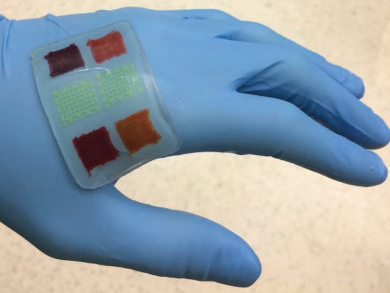Modern wound dressings do not just protect wounds from dirt and bacteria, but can have a range of additional functions. They can, e.g., relieve pain, deliver antibiotics and other drugs, or monitor the pH in the wound area. The pH of skin changes in the presence of bacteria, which provides a way to detect infections.
Mohsen Akbari, University of Victoria, Canada, and colleagues have developed a hydrogel wound dressing that combines the ability to detect bacterial infections with the delivery of antibiotics. The team prepared beads from ion-exchange resins that contain the pH indicators Brilliant Yellow or cabbage juice, respectively. These beads were loaded onto alginate fibers and incorporated into 3D-printed porous sensors (dark squares in the picture). In addition, the researchers prepared drug-releasing scaffolds made from alginate loaded with the antibiotic gentamicin sulfate (light yellow squares in the picture). The team then arranged the pH sensors and the drug-delivery scaffolds in a mold and incorporated them in an alginate hydrogel patch.
The team tested the resulting wound dressing both in vitro and in vivo (using mouse and pig models). They observed a color change in the pH sensors in the presence of either Staphylococcus aureus or Pseudomonas aeruginosa bacteria. The color change could be evaluated using a smartphone application, allowing for the easy diagnosis of infections. In tests on bacterial cultures, the gentamicin-loaded scaffolds were able to inhibit bacterial growth. Thus, the wound dressing can help to both detect and treat infections. The hydrogel dressing helps to maintain a moist wound environment, which promotes the healing process. According to the researchers, the patch is promising for managing wounds caused by trauma, surgery, or diabetes.
- An Advanced Multifunctional Hydrogel-Based Dressing for Wound Monitoring and Drug Delivery,
Bahram Mirani, Erik Pagan, Barbara Currie, Mohammad Ali Siddiqui, Reihaneh Hosseinzadeh, Pooria Mostafalu, Yu Shrike Zhang, Aziz Ghahary, Mohsen Akbari,
Adv. Healthcare Mater. 2017.
DOI: 10.1002/adhm.201700718




